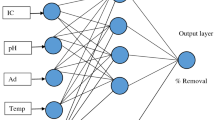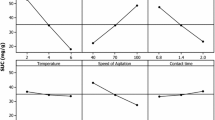Abstract
Copper biosorption potential of the biomass prepared from shells of sea urchin from aqueous solutions at optimum process conditions was studied. Response surface methodology and artificial neural network combined with central composite design were used for modeling and optimization of biosorption and to study interaction effects of process variables. A two-level three-factor face-centered central composite design was used for the experimental design. The influence of pH, initial copper concentration and biosorbent dosage on biosorption of copper was investigated. Prediction capacities of both models were compared and found that response surface methodology showed better prediction performance than artificial neural networks. Kinetic data were well fitted to second-order rate equation showing maximum biosorption capacity of 15.625 mg/g for 100 mg/l metal solution concentration. It was further confirmed by fitting the data to Elovich model. Biosorption mechanism was investigated using intra-particle diffusion and Boyd models. The optimum copper removal efficiency of the biosorbent was found as 89.09%.







Similar content being viewed by others
References
Aravind J, Lenin C, Nancyflavia C, Rashika P, Saravanan S (2015) Response surface methodology optimization of nickel (II) removal using pigeon pea pod biosorbent. Int J Environ Sci Technol 12(1):105–114
Boyd GE, Adamson AW, Myers LS Jr (1947) The exchange adsorption of ions from aqueous solutions by organic zeolites. II. Kinetics1. J Am Chem Soc 69(11):2836–2848
Chowdhury S, Saha P (2010) Sea shell powder as a new adsorbent to remove Basic Green 4 (Malachite Green) from aqueous solutions: equilibrium, kinetic and thermodynamic studies. Chem Eng J 164(1):168–177
Deng L, Su Y, Su H, Wang X, Zhu X (2006) Biosorption of copper (II) and lead (II) from aqueous solutions by nonliving green algae Cladophora fascicularis: equilibrium, kinetics and environmental effects. Adsorption 12(4):267–277
Du Y, Lian F, Zhu L (2011) Biosorption of divalent Pb, Cd and Zn on aragonite and calcite mollusk shells. Environ Pollut 159(7):1763–1768
Dutta M, Basu JK (2013) Application of artificial neural network for prediction of Pb(II) adsorption characteristics. Environ Sci Pollut Res 20(5):3322–3330
Geyikçi F, Kılıç E, Çoruh S, Elevli S (2012) Modelling of lead adsorption from industrial sludge leachate on red mud by using RSM and ANN. Chem Eng J 183:53–59
Ghosh A, Das P, Sinha K (2015) Modeling of biosorption of Cu(II) by alkali-modified spent tea leaves using response surface methodology (RSM) and artificial neural network (ANN). Appl Water Sci 5(2):191–199
Gupta S, Babu BV (2009) Removal of toxic metal Cr(VI) from aqueous solutions using sawdust as adsorbent: equilibrium, kinetics and regeneration studies. Chem Eng J 150(2):352–365
Han R, Zhang L, Song C, Zhang M, Zhu H, Zhang L (2010) Characterization of modified wheat straw, kinetic and equilibrium study about copper ion and methylene blue adsorption in batch mode. Carbohyd Polym 79(4):1140–1149
Jafari SA, Jamali A, Hosseini A (2015) Cadmium removal from aqueous solution by brown seaweed, Sargassum angustifolium. Korean J Chem Eng 32:2053–2057
Jeon C, Park JY, Yoo YJ (2001) Removal of heavy metals in plating wastewater using carboxylated alginic acid. Korean J Chem Eng 18(6):955–960
Kellner R, Mermet JM, Otto M, Valcarcel M, Widmer HM (2004) Analytical chemistry: a modern approach to analytical science. Germany: Wiley-VCH; ISBN 3-527-30, 590-594
Kim TY, Park SK, Cho SY, Kim HB, Kang Y, Kim SD, Kim SJ (2005) Adsorption of heavy metals by brewery biomass. Korean J Chem Eng 22(1):91–98
Krishnani KK, Meng X, Christodoulatos C, Boddu VM (2008) Biosorption mechanism of nine different heavy metals onto biomatrix from rice husk. J Hazard Mater 153(3):1222–1234
Kumar R, Chawla J (2014) Removal of cadmium ion from water/wastewater by nano-metal oxides: a review. Water Qual Exposure Health 5(4):215–226
Li K, Wang X (2009) Adsorptive removal of Pb (II) by activated carbon prepared from Spartina alterniflora: equilibrium, kinetics and thermodynamics. Biores Technol 100(11):2810–2815
Manohari R, Yogalakshmi KN (2016) Optimization of Cu (II) removal by response surface methodology using root nodule endophytic bacteria isolated from vigna unguiculata. Water Air Soil Pollut 227(8):285–293
Masukume M, Onyango MS, Maree JP (2014) Sea shell derived adsorbent and its potential for treating acid mine drainage. Int J Miner Process 133:52–59
Mata YN, Blázquez ML, Ballester A, González F, Munoz JA (2009) Biosorption of cadmium, lead and copper with calcium alginate xerogels and immobilized Fucus vesiculosus. J Hazard Mater 163(2):555–562
Murugesan S, Rajiv S, Thanapalan M (2009) Optimization of process variables for a biosorption of nickel (II) using response surface method. Korean J Chem Eng 26(2):364–370
Pan K, Wang WX (2012) Trace metal contamination in estuarine and coastal environments in China. Sci Total Environ 421:3–16
Peña-Rodríguez S, Fernández-Calviño D, Nóvoa-Muñoz JC, Arias-Estévez M, Núñez-Delgado A, Fernández-Sanjurjo MJ, Álvarez-Rodríguez E (2010) Kinetics of Hg (II) adsorption and desorption in calcined mussel shells. J Hazard Mater 180(1):622–627
Ravikumar R, Renuka K, Sindhu V, Malarmathi KB (2013) Response surface methodology and artificial neural network for modeling and optimization of distillery spent wash treatment using phormidium valderianum BDU 140441. Polish J Environ Stud 22(4):1143–1152
Sugashini S, Begum KMS (2013) Optimization using central composite design (CCD) for the biosorption of Cr (VI) ions by cross linked chitosan carbonized rice husk (CCACR). Clean Technol Environ Policy 15(2):293–302
Volesky B (2001) Detoxification of metal-bearing effluents: biosorption for the next century. Hydrometallurgy 59(2):203–216
Weber WJ, Morris JC (1964) Equilibria and capacities for adsorption on carbon. J Sanit Eng Div 90(3):79–108
Zalga A, Kareiva A (2012) Characteristics of naturally derived calcium compounds used in food industry. Chemija 23:76–85
Acknowledgement
We would like to thank entire team of Center of Excellence for Advanced Materials, Manufacturing, Processing and Characterization (CoExAMMPC) of Vignan’s Foundation for Science and Technology, Guntur and Advanced Analytical Laboratory of Andhra University, Visakhapatnam for their support in entire instrumental analysis.
Author information
Authors and Affiliations
Corresponding author
Ethics declarations
Conflict of interest
The authors declare that they have no conflict of interest in the publication.
Additional information
Editorial responsibility: Hari Pant.
Rights and permissions
About this article
Cite this article
John Babu, D., King, P. & Prasanna Kumar, Y. Optimization of Cu (II) biosorption onto sea urchin test using response surface methodology and artificial neural networks. Int. J. Environ. Sci. Technol. 16, 1885–1896 (2019). https://doi.org/10.1007/s13762-018-1747-2
Received:
Revised:
Accepted:
Published:
Issue Date:
DOI: https://doi.org/10.1007/s13762-018-1747-2




